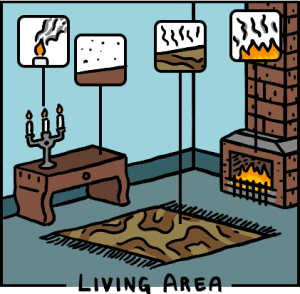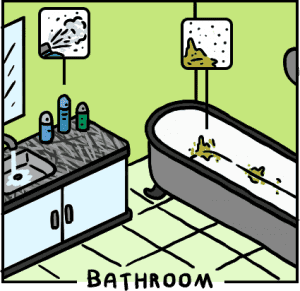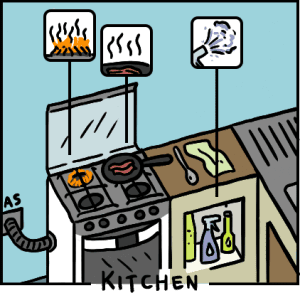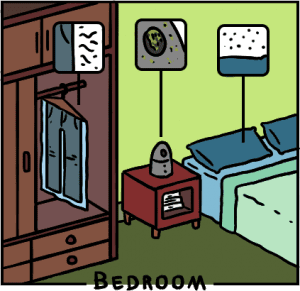Poor indoor air quality is a major issue for many homeowners. While there is a multitude of factors that impact indoor air quality (and some are quite uncontrollable) there are also sources in your space that worsen air quality. These indoor air pollutants lurk throughout your home—from the living room to the bathroom to the garage. Find out what the most common sources are!
What Is Indoor Air Pollution?
Indoor air pollutants originate from sources that exist both in the home and outside and negatively impact indoor air quality. These sources release gases or hazardous particles into the air, resulting in indoor pollution. How long pollutants stay in your home’s air supply and circulate through the space depends on air quality and the HVAC system. IAQ control methods like ventilation, purification, filtration and humidity control all influence how a space is affected by indoor pollutants.
Indoor pollution can cause both immediate and long-term effects. A reaction to dust mites or pet dander may be instant itchy eyes or sneezing and a runny nose. However, a reaction to long-term chemical exposure could result in a serious disease years later. The effects of home air pollution are varied, but serious nonetheless.
What Are Common Indoor Air Pollutants?
There are several kinds of indoor air pollutants and many potential indoor sources. Live sources like mold and cockroaches differ from chemical sources like carbon monoxide, ozone and volatile organic compounds (VOCs). Some of the more common sources of indoor air pollution include tobacco products and secondhand smoke, outdoor sources like radon and pesticides, fuel-burning combustion appliances and specific building materials.
Certain indoor air pollutants are based on uncontrollable factors. For example, your home’s radon risk is based on location and surrounding soil. However, there are certain indoor pollutants that depend on us and our actions. Things like personal care products, household cleaners, the furniture we choose, the cooking methods we prefer all have an impact on air quality and air pollution. For this reason, it’s important to be aware of the more common indoor sources of indoor air pollution, where they lurk in your home and how to intervene.
Common Sources of Indoor Air Pollution in Your Home
Our living areas are often the heart of the home. Living rooms, sitting rooms, great rooms, dens—you name it, these are the places many of us gather and spend time together. The furniture, decorations and materials in said spaces can also be sources of indoor air pollution.
- Carpets often release fumes when new. Brand new carpets enter your home with glue, vinyl and chemicals leftover from the factory, which then enter your indoor air. This is a process known as off-gassing and can cause serious headaches, nausea and asthma symptoms. Most chemicals are released within a few months of having a new product, but off-gassing can continue up to five years after install.
- Wood furniture can release formaldehyde gas. A known carcinogen, formaldehyde is colorless but has a strong odor. It is often found in glue and adhesives used to seal wood furniture.

- Fireplaces release a lot of pollutants, including carbon monoxide and nitrogen dioxide. This is why it’s important to make sure the fireplace flue is open during use. Wood-burning fireplaces in particular are worse for air quality and release more particulates that can make breathing difficult.
- Pets and their fur, they have a LOT. Animals like cats, dogs and bunnies that shed create a lot of pet dander. Dander is a common allergen that worsens indoor pollution in your home.
- Candles, while not limited to the living room and a fun decorative piece, emit pollutants that worsen air quality.
Bathroom
Air quality changes quickly by seemingly small actions, which is why you should be extra aware and cautious of indoor air pollutants in small spaces, like bathrooms.
- Aerosols like hair spray, dry shampoo, aerosol deodorant and air fresheners emit gases. Bathrooms are often smaller spaces and aerosols can drastically reduce air quality.
- Moisture builds up quickly in bathrooms due to showers, baths and steam. It’s important to keep moisture under control as damp areas create an environment that mold and mildew thrive in. Running localized exhaust fans can help keep moisture levels down.

Kitchen
Kitchens are another location oft considered the heart of the home. Due to consistent cooking, baking and cleaning, kitchen air quality fluctuate regularly. The products and appliances you choose can affect what indoor air pollutants are produced in the process.
- Stoves create indoor air pollution. Gas, wood and electric stovetops all produce different types of indoor air pollutants. Recent research shows that gas stoves in particular release carbon monoxide, formaldehyde and others into the air, and thus must be used carefully. Always use the localized exhaust fan to ventilate the space when cooking.
- Ovens also emit particulate matter and increase the number of pollutants present in your kitchen. Similar to stovetops, gas ovens are worse offenders than electric ones. And the self-cleaning setting on the oven, though handy, releases a large number of contaminants and hazardous chemicals into the air.

- Cooking itself even creates VOCs and particulate matter. Any process that involves heating ingredients, oils and fats at a high temperature creates indoor air pollution. That means frying, baking, browning and broiling all worsen indoor air quality.
- Cleaning products also produce VOCs and other chemicals. Products that most of us keep in the kitchen like surface cleaners, air fresheners, oven cleaners, aerosol sprays, soaps and polishes all contribute. Some of these products aggravate allergy and asthma symptoms while others cause headaches or trouble breathing.
Bedroom
Your bedroom is a safe haven. In order to keep air quality at its best and your sleep undisturbed, watch out for these potential sources of pollution.
- Dry cleaning sitting in the back of your closet untouched can emit gases and pollutants. Most dry cleaners rely on chemicals for that pristine starch press, which then remains on the clothes afterward. Make sure to air out your clothes before contaminating your closet space and bedroom air.
- Humidifiers, if not used or cleaned properly, can lead to bacteria growth. Essential oil diffusers and small portable health humidifiers have grown in popularity in recent years. However, the consequences of these products far outweigh the benefits if they are not cleaned regularly. Make sure to change the water every day!

Garage, Shed or Storage Area
Garages, sheds and storage areas are often forgotten about when considering indoor air quality. However, these spaces often hold the more dangerous chemicals, appliances, and thus—indoor air pollution sources. If this area is attached to your home, it’s even more important to consider the products and appliances stored there.

- Pesticides and fertilizers are explicit chemicals. While they serve a purpose, it’s important to remember they are serious chemicals and to treat them accordingly. Pesticide pollution is a frequent problem, particularly if they are not used carefully indoors.
- Paints are full of VOCs. Even if the products are stored out of sight, they can still impact indoor air quality. To reduce indoor air pollution, make sure to ventilate when paints and solvents are open, closely seal cans and clean brushes thoroughly.
- Cleaning products (again) easily become a source of indoor air pollution. Wherever you keep the more serious cleaning supplies, like bleach and detergents, make sure they are stored safely.
The Importance of Source Control
Indoor air pollutants present many serious health and home quality threats. Having an awareness of the more common indoor air pollutants and likely sources in your home is a helpful first step. Knowledge of where, what and how these prevalent indoor air pollutants spread and worsen your home’s air quality will make you a more vigilant homeowner. Curious about indoor air quality upgrades in addition to source control? Reach out to us with your questions today, as the homeowner’s advocate, we’re happy to help!




